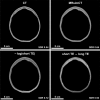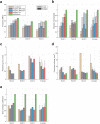Comparison between MR and CT imaging used to correct for skull-induced phase aberrations during transcranial focused ultrasound
- PMID: 35927449
- PMCID: PMC9352781
- DOI: 10.1038/s41598-022-17319-4
Comparison between MR and CT imaging used to correct for skull-induced phase aberrations during transcranial focused ultrasound
Abstract
Transcranial focused ultrasound with the InSightec Exablate system uses thermal ablation for the treatment of movement and mood disorders and blood brain barrier disruption for tumor therapy. The system uses computed tomography (CT) images to calculate phase corrections that account for aberrations caused by the human skull. This work investigates whether magnetic resonance (MR) images can be used as an alternative to CT images to calculate phase corrections. Phase corrections were calculated using the gold standard hydrophone method and the standard of care InSightec ray tracing method. MR binary image mask, MR-simulated-CT (MRsimCT), and CT images of three ex vivo human skulls were supplied as inputs to the InSightec ray tracing method. The degassed ex vivo human skulls were sonicated with a 670 kHz hemispherical phased array transducer (InSightec Exablate 4000). 3D raster scans of the beam profiles were acquired using a hydrophone mounted on a 3-axis positioner system. Focal spots were evaluated using six metrics: pressure at the target, peak pressure, intensity at the target, peak intensity, positioning error, and focal spot volume. Targets at the geometric focus and 5 mm lateral to the geometric focus were investigated. There was no statistical difference between any of the metrics at either target using either MRsimCT or CT for phase aberration correction. As opposed to the MRsimCT, the use of CT images for aberration correction requires registration to the treatment day MR images; CT misregistration within a range of ± 2 degrees of rotation error along three dimensions was shown to reduce focal spot intensity by up to 9.4%. MRsimCT images used for phase aberration correction for the skull produce similar results as CT-based correction, while avoiding both CT to MR registration errors and unnecessary patient exposure to ionizing radiation.
© 2022. The Author(s).
Conflict of interest statement
The authors declare no competing interests.
Figures






Similar articles
-
Transcranial focused ultrasound phase correction using the hybrid angular spectrum method.Sci Rep. 2021 Mar 22;11(1):6532. doi: 10.1038/s41598-021-85535-5. Sci Rep. 2021. PMID: 33753771 Free PMC article.
-
Ultrashort echo-time MRI versus CT for skull aberration correction in MR-guided transcranial focused ultrasound: In vitro comparison on human calvaria.Med Phys. 2015 May;42(5):2223-33. doi: 10.1118/1.4916656. Med Phys. 2015. PMID: 25979016
-
Ultrasound focusing using magnetic resonance acoustic radiation force imaging: application to ultrasound transcranial therapy.Med Phys. 2010 Jun;37(6):2934-42. doi: 10.1118/1.3395553. Med Phys. 2010. PMID: 20632605
-
Ultra-short time-echo based ray tracing for transcranial focused ultrasound aberration correction in human calvaria.Phys Med Biol. 2025 Mar 21;70(7). doi: 10.1088/1361-6560/ad4f44. Phys Med Biol. 2025. PMID: 38776944
-
A review of numerical and experimental compensation techniques for skull-induced phase aberrations in transcranial focused ultrasound.Int J Hyperthermia. 2014 Feb;30(1):36-46. doi: 10.3109/02656736.2013.861519. Epub 2013 Dec 10. Int J Hyperthermia. 2014. PMID: 24325307 Review.
Cited by
-
Generating Patient-Specific Acoustic Simulations for Transcranial Focused Ultrasound Procedures Based on Optical Tracking Information.IEEE Open J Ultrason Ferroelectr Freq Control. 2023;3:146-156. doi: 10.1109/ojuffc.2023.3318560. Epub 2023 Sep 25. IEEE Open J Ultrason Ferroelectr Freq Control. 2023. PMID: 38222464 Free PMC article.
-
Improving Targeting Specificity of Transcranial Focused Ultrasound in Subject Specific Head Models Using a Random Array Transducer: A k-Wave Simulation Study.IEEE Access. 2025;13:113179-113193. doi: 10.1109/access.2025.3584245. Epub 2025 Jun 30. IEEE Access. 2025. PMID: 40843191 Free PMC article.
-
Evaluation of synthetically generated computed tomography for use in transcranial focused ultrasound procedures.J Med Imaging (Bellingham). 2023 Sep;10(5):055001. doi: 10.1117/1.JMI.10.5.055001. Epub 2023 Sep 22. J Med Imaging (Bellingham). 2023. PMID: 37744953 Free PMC article.
-
Innovative aberration correction in ultrasound diagnostics with direct phase estimation for enhanced image quality.Phys Eng Sci Med. 2023 Dec;46(4):1765-1778. doi: 10.1007/s13246-023-01338-0. Epub 2023 Oct 5. Phys Eng Sci Med. 2023. PMID: 37796368
-
Model-based navigation of transcranial focused ultrasound neuromodulation in humans: Application to targeting the amygdala and thalamus.Brain Stimul. 2024 Jul-Aug;17(4):958-969. doi: 10.1016/j.brs.2024.07.019. Epub 2024 Jul 31. Brain Stimul. 2024. PMID: 39094682 Free PMC article.
References
Publication types
MeSH terms
Grants and funding
LinkOut - more resources
Full Text Sources
Medical
Research Materials

